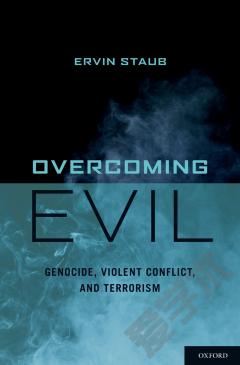Overcoming Evil —— Genocide, Violent Conflict, and Terrorism
----- 克服罪恶:种族灭绝罪,暴力冲突和恐怖主义
CONTENTS Preface and Acknowledgments Chapter 1. Introduction. I. Origins, Prevention, Reconciliation Chapter 2. Introduction. II. Early and Late Prevention, The Costs of Violence, Evil and Goodness Part I: The Origins of Mass Violence Chapter 3. The Sources of Conflict Between Groups and Primary Examples Chapter 4. Instigating Conditions: Starting Points of Mass Violence Chapter 5. Psychological and Societal/Group Processes that Arise from Instigating Conditions Chapter 6. Learning by Doing in Individuals and Groups: The Evolution of Extreme Violence Chapter 7. Internal and External Bystanders: Their Passivity, Complicity, and Role in the Evolution of Violence Chapter 8. Cultural/Societal Characteristics that Make Hostility and Violence More Likely Chapter 9. Perpetration and the Perpetrators Chapter 10. Understanding the Woundedness/Psychological Transformation of All Parties in Mass Violence. Part II. Prevention and Reconciliation Chapter 11. Introduction and late prevention. Chapter 12. Promoting Understanding, Healing and Reconciliation in Rwanda Chapter 13. Constructive Responses to Difficult Life Conditions and Conflict, Preventive Diplomacy and Dialogue Chapter 14. Developing Positive Orientation to the "Other": Humanizing and Contact with the Other. Chapter 15. Beyond "us" and "them": Constructive Ideologies and Groups, Common Identities, Inclusive Caring, and Pluralism Chapter 16. Changing Hearts and Minds: Information, Peace Education, and Public Education in Rwanda and the Congo Chapter 17. The Potential and Power of Active Bystanders: Citizens, Leaders, Nations, the International System. Chapter 18. Generating Action by Leaders, Citizens, Creating Structures for Prevention. Chapter 19. Healing/Psychological Recovery and Reconciliation Chapter 20. Other Elements of Reconciliation: Complex Truth, Collective Memory, Shared History and Justice Chapter 21. Forgiveness, Healing and Reconciliation Chapter 22. Raising Inclusively Caring, Morally Courageous Children and Altruism Born of Suffering Chapter 23. Recommendations and Conclusions
{{comment.content}}








 京公网安备 11010802027623号
京公网安备 11010802027623号